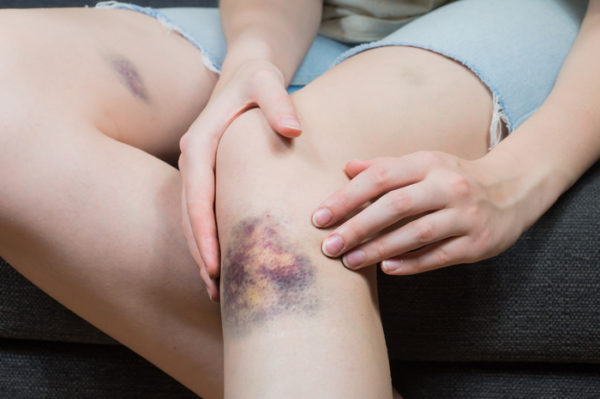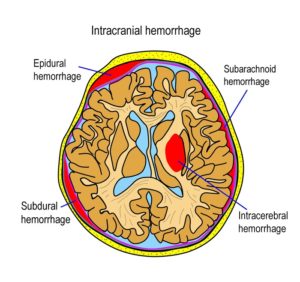Bruising After a Car Accident: Is It Normal and When to Be Concerned

Violent crashes often lead to serious external and internal trauma. One of the most common symptoms people experience after a collision is bruising.
A bruise occurs when blood vessels beneath the skin are crushed and break open. Since the blood is trapped under the skin, the leakage appears as dark red or purple marks. They can feel tender or swollen to the touch.
Bruising can happen anywhere on the body. Victims of car accidents or other sudden, traumatic impacts may experience bruises on their skin, muscles, organs, breasts, bones, and even brain.
Minor bruises last about two weeks. But some can take months to fade away. They start off red, then turn purplish-blue, and then yellowish-green before going away.
A doctor can diagnose your injuries and begin treatment. That’s why it’s important to get medical attention as soon as possible if you’ve been involved in a car accident.
Bruise vs Contusion vs Hematoma
In medical parlance, bruises are often referred to as contusions (from the Latin contūsus meaning “bruised, crushed”). Hematomas happen when a large collection of blood forms under the skin and in a muscle (from the Greek haima “blood” and oma “mass, tumor”). Instead of cleaning the excess blood up, the body walls it off, forming a lump. This may need to be drained by a medical professional.
Internal Bruising
 When people think of bruises, we often think of surface-level injuries. But contusions can also develop deep inside the body.
When people think of bruises, we often think of surface-level injuries. But contusions can also develop deep inside the body.
Internal bruising is often seen in the muscles of the legs and back. If the abdomen was crushed or struck, organs and tissues such as the liver and spleen can sustain damage.
The symptoms of internal bruising include:
- Pain and tenderness
- Bruising under the skin
- Limited range of motion in the joints (muscle bruise)
- Blood pooling around the injured site (hematoma)
- Blood in the urine (kidney bruise, bladder bruise)
Treating bruising in the stomach and abdomen depends on the location and how severe the injury is. A doctor may order overnight observation, bed rest, medication, intravenous (IV) fluids, blood transfusions, or surgery to drain excess fluid or to find and seal the source of the bleeding.
Brain Bruising
 A blow to the head or whiplash can a brain bleed or skull fracture. A brain bruise is called a coup-contrecoup injury. There is an initial bruise (coup) where the brain is thrown against one side of the skull due to trauma, and a secondary bruise (contrecoup) when it smashes against the other side. In rollover crashes or collisions where there are multiple hits, this can happen more than once and result in severe injuries to the brain.
A blow to the head or whiplash can a brain bleed or skull fracture. A brain bruise is called a coup-contrecoup injury. There is an initial bruise (coup) where the brain is thrown against one side of the skull due to trauma, and a secondary bruise (contrecoup) when it smashes against the other side. In rollover crashes or collisions where there are multiple hits, this can happen more than once and result in severe injuries to the brain.
A hematoma can develop between the skull and the brain along the three protective membranes that shield the brain as well as inside the brain itself. These are known as intracranial hematomas. An epidural hematoma develops between the skull and dura mater, a subdural hematoma is located between the dura mater and the arachnoid mater, and a subarachnoid hematoma develops between the arachnoid mater and the pia mater. An intracerebral hematoma means the bleeding is located inside the brain.
Learn More: Traumatic Brain Injury After a Wreck or Fall: Types, Symptoms, and Treatment
Bone Bruising
A bone contusion can be especially painful. They take longer to heal, usually about one to two months. Although bone bruises can appear on any bone, they most often happen to those close to the skin, such as the forearm or knees. Symptoms include stiffness, joint swelling, tenderness, trouble using the injured joint, and damaged ligaments. Your doctor may recommend wearing a temporary brace or splint and increasing your intake of vitamin D and calcium.
In some cases, we receive clients who have experienced a sacral contusion or coccyx contusion (i.e., your tailbone). This is caused by a direct blow to the five bones of the sacrum, the lowest part of the spine, causing pain and swelling when sitting or lying down. A bruise to the sacrum can take a few weeks to heal; if there is a fracture, it can take a month or more.
Chest Bruising
A contusion of the chest results from a traumatic blow to the upper torso. In a car accident, this can occur when a person’s chest smashes into the steering wheel, or they are jerked against their seat belt.
A bruised heart (myocardial contusion), bruised lung (pulmonary contusion), bruised rib, or bruised sternum after a car accident, fall, or due to chest compressions during CPR is a cause for serious concern. These can lead to complications if not treated. Symptoms may include:
- Extreme pain above the ribs
- Crackling sensation in the ribcage
- Abnormal chest movements
- Shortness of breath or wheezing
- Discolored chest skin
- Tenderness
- Increased heart rate
- Low blood pressure
- Weakness
- Fatigue
- Lightheadedness
- Nausea or vomiting
- Coughing up blood or sputum
A doctor may order tests to get a clearer understanding of what’s wrong. Chest X-rays, CT scans, echocardiograms, electrocardiograms, and blood counts are some of the tests they can use. A contusion of the heart may require draining blood from the injured area, surgery to repair blood vessels, or a pacemaker.
Seat Belt Injuries
Seat belts are designed to save lives. But the force of a crash can cause it to snap across a person’s chest as they jerk forward or too the side. It may have saved your life, but you are still left hurt from the collision. A seat belt bruise or scrape may appear on the chest, neck, or stomach after a car accident. It’s normal to feel tight and sore the day after. Severe chest pain, neck pain, or complications, however, are not.
Learn More: 5 Myths and Facts About Seat Belts
Airbag Injuries
Airbags have proven to save lives since they were first introduced to vehicles in the 1970s. Although the technology has improved significantly since then, injuries can still sometimes result from the force of the airbags striking a person in a major or minor car accident. Airbags may cause bruising of the face, chest, arms, breasts, and other internal organs. Deployment errors or malfunctions may also increase a person’s risk of injury.
How to Treat Bruises
Ice the injured area with an ice pack or frozen vegetable package (do not apply ice directly to the skin) and keep it elevated above your heart. After 48 hours, use heat such as a warm washcloth on the bruised area for several minutes a few times a day to increase blood flow and allow the skin to reabsorb it.
Avoid NSAIDs (nonsteroidal anti-inflammatory drugs) like aspirin or ibuprofen because they slow down clotting — use acetaminophen instead. If a leg bruise is severe enough that you can’t put weight on it, you may need crutches.
Serious bruises may require medical care. Here are some examples of when to call a doctor:
- Bruising occurs for no apparent reason
- A bruise appears infected
- The bruise is painful and under a toenail or fingernail
- Long-lasting bruises
- Bruising that spreads or worsens
- Pain, numbness, and weakness in one or both legs (back bruise)
- Possible broken bone
- Nausea or vomiting
- Elevated pulse
- Pale skin
- Shallow breathing
- Dizziness or fainting
- Confusion
- Extreme pain and swelling (especially if you take blood-thinning medication)
- Fever above 100°F (or as directed by medical staff)
- Bruising behind the ear (Battle’s sign, which may indicate a skull fracture)
Swelling and severe pain may indicate a fracture. In this case, a doctor will likely order an X-ray to assess the damage. Call 911 if you experience blood in your vomit, stool, or urine; have trouble breathing, or have a seizure.
Don’t Underestimate Soreness and Bruising After a Wreck
Injuries from a motor vehicle accident, especially internal ones, can have delayed symptoms. Soft tissue trauma and bad bruises after a car crash are just as serious as open wounds. It’s important you get treatment for your injuries ASAP after a crash.
Car accidents can also be emotionally distressing events. You might be struggling with the next steps or don’t know how to answer the insurance company’s questions. This could be your first serious wreck, leaving you feeling overwhelmed.
Having a legal partner guide you through the process and talk to the insurance adjusters on your behalf can help ease that burden. Our personal injury lawyers and case managers are here to answer your questions and get you the financial payout you need to move on with your life.
Try Gary Martin Hays & Associate’s free case evaluation today.

 Find a location near you
Find a location near you